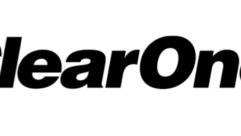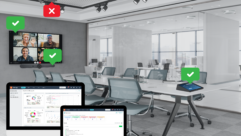Crucial AV Software Tools
It’s conceivable that with AV software tools you could design an entire building, install a complex AV system, configure individual spaces for optimal acoustics, and present the client with an equipment list, bid proposal, and even let them hear what the individual spaces will sound like ? without ever breaking ground.
It’s conceivable that with AV software tools you could design an entire building, install a complex AV system, configure individual spaces for optimal acoustics, and present the client with an equipment list, bid proposal, and even let them hear what the individual spaces will sound like — without ever breaking ground. AV software tools can eliminate unforeseen costs, conflicts between different trades on the job site, and costly modifications done on the fly. Often the only thing standing between increased efficiency and profitability is ensuring everyone on a project is proficient with these tools.
Following is a sample of some of the most popular AV software tools being used today by AV and AV-related industry professionals. Granted, some of these programs are used primarily by architects. But if you’re looking to win a high-end job in a corporate headquarters or a higher education facility, knowledge of these software tools can give you an advantage over the competition.
AutoCAD
Autodesk, a San Rafael, CA-based building, infrastructure, and media and entertainment software solutions company
For designing, drafting, and detailing a space, this software has become the industry standard. An important tool for architects and designers, AV systems integrators and consultants must also be familiar with this program if they want to be competitive in bidding on large projects, says Kenneth Dickensheets, CTO and principal consultant at Austin, TX-based Dickensheets Design Associates. “We’re pro AV systems designers, and the majority of our clients are architects who are designing a space,” he says. “We have to able to speak their language. In order to do so, you have to be able to use their tools, and about 90 percent of the architects in the country use AutoCAD.”
Dickensheets adds that besides being able to effectively communicate with architects on the job site, often complete designs of all systems for the construction of a building are bundled together, so you need to be able to identify and work around other systems. “We have to provide documentation on system design, and oftentimes it has to go out as a part of a package,” he says. “So it all has to be in the same format, and we have to be able to see where walls, HVAC, and conduit are placed.”
For AV systems integrators who might not have the time or desire to master the full version of AutoCAD, there’s AutoCAD Lite, which Dickensheets says some of his employees use for smaller projects.
Initial software cost: $3,995 for AutoCAD 2007.
VidCAD
CommSYS Design LLC, a Las Cruces, NM-based engineering software company
This software design tool serves a similar function as AutoCAD. But just as Macs and PCs have different formats, so do VidCAD and AutoCAD, says Rich Merriam, project manager at Tampa, FL-based AV and broadcast systems integrator Professional Communications Systems. “A big difference is that with VidCAD, you don’t have to know the AutoCAD commands,” says Merriam, who uses both programs. “You have an extensive library of AV and broadcast equipment, and you don’t have to draw any of this equipment. You just call up the library, select the equipment, and it’s drawn for you.”
VidCAD also includes a database, which is maintained and automatically updated as changes are made in the design. “If there’s anything that isn’t in the library, you can create it yourself and access it whenever you need it,” says Merriam, noting that as you add equipment from the library to a project, VidCAD automatically creates an Excel database so no equipment is left off the final invoice. “The amount of time it saves me to put together projects is probably 75 percent,” he says.
Initial software cost: $1,995 to $4,450, depending on configuration.
Revit Building
Autodesk, a San Rafael, CA-based building, infrastructure, and media and entertainment software solutions company
Brian Brustad, CTS-D, a designer at Washington, D.C.-based architectural firm RTKL, describes Revit Building as the future of CAD-based platforms. Produced by the same company that offers AutoCAD, Revit includes the same functionality as AutoCAD, but also adds 3D rendering, real-time design modifications, and equipment and information databasing. It’s these new features that Brustad says will make CAD-based programs — and Revit specifically — easier to use and more efficient for AV professionals in the future.
“It’s going to make it easier on the AV systems integrator because it’s backed by a database similar to D-Tools, which allows you to have all of the invoicing and costs associated with the systems done for you,” he says. “You’ll also be able to work in real-time coordinating with mechanical, plumbing, and structural trades to make sure that your systems — where they’re shown to be installed — aren’t being obstructed by another trade.”
Brustad says that Revit hasn’t been widely adopted yet, and admits that the initial learning curve is pretty steep, but if you’re familiar with AutoCAD, the process will be sped up, putting you one step ahead of your competitors.
Initial software cost: $5,495 (multi-user discounts available).
EASE
Renkus-Heinz, a Foothill Ranch, CA-based audio technology products and software manufacturer
When installing an audio system in a room, seasoned AV professionals have a pretty good idea about how to approach the design. However, it’s always helpful to confirm your assumptions, which is where the EASE acoustical room modeling tool earns its reputation as a must-have in any AV pro’s tool box. But one thing EASE is not, says Christopher “Topper” Sowden, CEO of Fort Worth, TX-based acoustical and entertainment technologies consulting firm Sowden and Associates, is an acoustical tool designed to develop initial acoustical models of a space. “You have to have knowledge of the acoustical products and the electro-acoustical products to really end up with a successful solution with this tool,” Sowden says. “It’s literally more of a confirmation and development tool to be used only in the assessment and confirmation of a design approach.”
But if you have the requisite acoustical knowledge, EASE allows you to assess and enhance your audio systems. Sowden notes that EASE can be helpful to less experienced designers because of its 3D resultant feature. “Visualization is something that you have to have in designing a project,” he says. “This provides the novice designer with a better idea of the space.”
Sowden adds that EASE’s end-result map of sound levels and the distributed sound analysis of a room are two of its greatest assets, helping AV pros to quickly confirm a design and move on. EASE can also be a valuable tool in client relations — more so than showing a client a CAD drawing or a graph of reverberation readings. Its coverage mapping clearly demonstrates to clients that all seating spaces will be covered for sound, and its “AURA” add-on auralization module is often a crowd pleaser. “We’ve demonstrated to clients the ability to provide true auralization of loudspeaker systems in facilities through listening tests,” Sowden says. “It’s impressive to be able to demonstrate the actual response of the system in the space.”
Initial software cost: starts at $3,700 for EASE 4.1 (includes five user keys).
SmaartLive
SIA Software Company, a Whitinsville, MA-based audio and acoustical test and measurement software firm
Once a room’s audio components have been selected and aligned using EASE — or other predictive analysis tools — more detailed adjustments still need to be made for optimal audio performance. This is where SmaartLive dual-FFT audio measurement software comes into play. Designed for audio frequency measurement, analysis, and data logging, the software includes the ability to remotely control equalizers and DSP processors. These adjustments and capabilities are why Jerrold Stevens, CTS, senior consultant at Dallas-based consulting firm Pelton Marsh Kinsella, says he uses SmaartLive on 95 percent of his projects.
“It’s all about determining your processor settings for equalizers and delay times,” says Stevens, adding that he uses SmaartLive instead of competing tools because of its real-time analysis capabilities. “I like to look at changes in real time,” he says. “I’ll make adjustments in the DSP, and watch how it changes the results at the test microphone.”
Stevens says that SmaartLive’s dual-FFT method also makes it preferable to other programs he’s used. “TEF works well, but it’s not really real time,” he says. “It uses a sine wave sweep, does a measurement, and gives you a resulting response or transfer function. Then you make another adjustment to your signal processing, and run another sweep. The dual-FFT process allows you to make changes in real time, and see those changes occurring while you’re doing the measurement.”
Stevens says the learning curve for the software is pretty short, and that it’s very user-friendly — but that doesn’t mean all AV pros can effectively use SmaartLive. “The other side is knowing and understanding what it is you’re measuring, and knowing how to interpret what SmaartLive is telling you,” he says. “If you don’t know acoustics, the behavior of sound, and what happens with sound from multiple sources, you’re not going to get anywhere.”
Initial software cost: $650 (SmaartLive version 5); licensing fees: $350 per additional seat.
D-Tools System Integrator
D-Tools, a Concord, CA-based AV systems integration software company
Gaining proficiency in AutoCAD, Revit, and VidCAD is basically a way for AV professionals to adapt to tools primarily tailored for other trades. However, D-Tools System Integrator is a software program specifically designed for AV pros. D-Tools includes a comprehensive suite of functions including design, proposal, and management capabilities. Compatible with both AutoCAD and Microsoft’s Vizio design software applications, System Integrator allows AV professionals to create additional dynamic elements that aren’t possible in the architectural-focused CAD programs, says Dave Lewis, design engineer at Vero Beach, FL-based custom AV installation company Select Audio Video.
“It ties in with a master dataset, and allows you to create custom reports, proposals, or a PowerPoint presentation for your client,” Lewis says. “You can’t do that just by using an AutoCAD drawing.”
Lewis also adds that D-Tools offers a databasing function that isn’t available in AutoCAD or Vizio. “Yes, you can do a drawing and schematic, but you can’t get equipment counts or detailed documentation from AutoCAD or Vizio without an engine like D-Tools on top of it,” explains Lewis, proposing that the program works best when partnered with AutoCAD or Vizio, rather than in its text-only version. This reduces the learning curve if you don’t have experience with those programs.
Initial software cost: ranges from $1,499 to $3,999, depending on configuration; additional licensing fees: One to five additional licenses are available at 30 percent below initial cost.
Stardraw A/V
Stardraw.com, a London-based design, development, and implementation software company
For AV pros who aren’t as comfortable working in AutoCAD-type programs, Stardraw A/V software can be used as a standalone AV systems design tool or integrated into AutoCAD. Jay McCutcheon, technical support coordinator at Nashville, TN-based AV systems design, engineering, and installation company Service Associates Nashville, says he chose Stardraw A/V as his primary design tool a few years ago because of its ease of use. “I came from a very hands-on background,” he says. “Stardraw allowed me to work without having a lot of CAD experience. I can do high-detailed work in the illustrator function, and save drawings in Stardraw into any AutoCAD file format and incorporate that in a print file for a contractor or architect.”
Another feature McCutcheon says he’s just starting to use — but that saves him valuable time —is the ability to create numerous Excel forms that show everything from the total price of installed equipment, including its cost along with labor, to the ability to send instructions to workers in the field. “If I want to look at the cable and connection schedule, it actually builds it for me inside Excel,” he says. “It tells me that this device connects to this device via this cable, labeled this way. I print that off, send it to the techs, and they know exactly what has to be hooked together, what the cable label is, and where it goes.”
McCutcheon says the learning curve is short, and that if you’re computer literate and understand a little bit of CAD, Stardraw A/V can make an immediate impact on your business.
Initial software cost: $2,500; each additional licensing fee: $1,250.
Paul Kramer is associate editor of Pro AV. He can be reached at [email protected].










